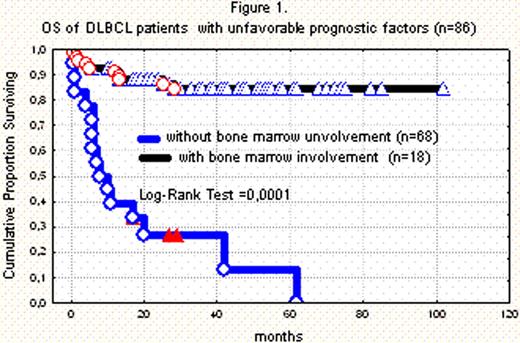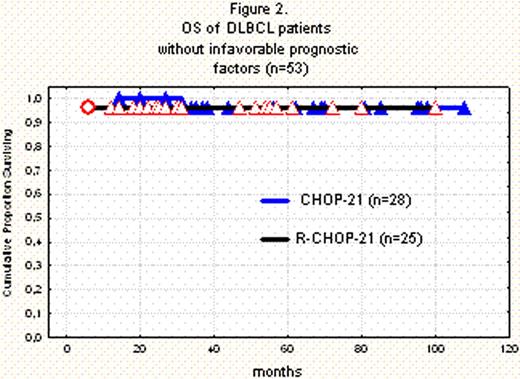Abstract
Abstract 2684
diffuse Large B-cell lymphoma (DLBCL) are aggressive but potentially curable with multi-agent chemotherapy. The R-CHOP regimen is standard therapy for treatment of DLBCL patients. Whereas attempts to improve outcome with more intensive chemotherapy failed to show additional benefit.
to set the indications to standard or intensive therapy in patients with nodal DLBCL and to evaluate the efficiency of modified protocol NHL-BFM-90 in adult patients.
139 patients with newly diagnosed nodal DLBCL were included in the study since January 2002 till December 2010. The diagnosis was established according to the criteria of the WHO classification. Diagnostic methods include neck, thorax, abdomen and pelvis CT scan, tumor biopsy bilateral bone marrow (BM) biopsy, lumbal puncture, MRT or scintigraphy of bones. Bone marrow involvement was found in 18 cases and confirmed by immunohistochemistry. Bulky disease, direct invasion to adjacent organs, III-IV stage according Ann-Arbor and increased level LDH were considered as the unfavorable prognostic factors. The patients were stratified into 2 groups: the first group with unfavorable prognostic factors (86 patients), the second group without unfavorable prognostic factors (53 patients). Median age in the first group was 53 years. There were 46 men and 40 women. The level of LDH was elevated in the 61 patients. III-IV stage without involvement of BM was diagnosed in the 35 patients, IV stage with BM involvement-in the 18 patients, bulky disease and direct invasion to adjacent organs-in the 33 patients. Median age in the second group was 55 years. There were 28 men and 25 women. All patients in the first group received intensive therapy by modified protocol NHL-BFM-90. The patients in the second group received chemotherapy CHOP-21(n=28) or R-CHOP-21 (n=25). The program NHL-BFM-90 was modified: the dose of methotrexate was 1,5 g/m2 for 12 hours and adriamycin 25 mg/m2 was infused in 1–2 days of course AA. All patients treated with this protocol gave written informed consent. We made spleneectomy to all the patients of splenic DLBCL before chemotherapy (n=20). The estimation of the chemotherapy efficiency was carried out according to the criteria of the International Working Group: rate of complete remissions (CR), overall (OS) and relapse-free (RFS) survival. The data were analyzed with SAS statistical package program. Statistical significance of the difference in the survival curves for two groups was calculated with Log-rank Test.
64 patients in the first group (74,4%) and 53 patients (100%) in the second group achieved CR. 5-year OS and RFS were 65% and 86% in the first group 96% and 100% in the second group, accordingly. In the first group the best results were obtained in patients without BM involvement. 5-year OS was 84% in these patients comparing 12% in patients with BM involvement–figure 1 (Log-Rank Test=0,0001). The rate of CR and OS were the same in CHOP-21 group and R-CHOP-21 group–figure 2 (Log-Rank Test=0,8).
The stated unfavorable prognostic factors allowed to stratify patients into prognostic groups. Modified program NHL-BFM-90 is effective treatment for adult patients with DLBCL with unfavorable prognostic factors. The concordant of BM involvement is the most strict prognostic factor.
No relevant conflicts of interest to declare.
Author notes
Asterisk with author names denotes non-ASH members.



This feature is available to Subscribers Only
Sign In or Create an Account Close Modal